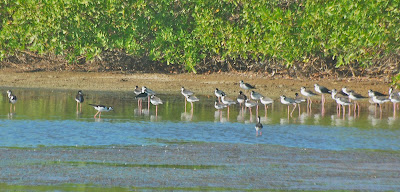
The Metropolitan Natural Park of Panama City is absurdly close to my home, ideal for rapid visits, which I did last saturday, february 25th, in company of Osvaldo Quintero and Rafael Luck (who was celebrating his birthday). My idea was to stay only a couple of hours, checking the trees at the entrance of the Mono Titi and La Cieneguita trails, and the bushes and trees close to the "vivero", both areas reported by Osvaldo as being quite good recently for mixed flocks visiting the fruiting "indio desnudo" trees. In fact, the trees were attracting tons of resident and migrant birds, but not as many as the previous days according to Osvaldo. However, we were delighted by the visitors. Most of them were flycatchers, the most dominant were the Streaked, Social and Rusty-margined Flycatchers (file photo from another place in Panama City), but also we saw (or heard) Bright-rumped Attilas, Tropical Kingbirds, Common Tody-Flycatchers, Southern Beardless and Paltry Tyrannulets and so on...

We also got many migrants, specially in a mixed flock passing at the opposite site of the trees, containing Chestnut-sided, Bay-breasted, Yellow, Protonothary, Golden-winged and Black-and-white Warblers, Northern Waterthrush and a female Rose-breasted Grosbeak. Close to them, a pair of Blue-crowned Motmots and a Squirrel Cuckoo gave some colors to the picture.

Walking towards the "vivero", the fruit feeders (actually bananas fixed in the fence) attracted Palm, Blue-gray, Plain-colored and Crimson-backed Tanagers, Red-legged Honeycreepers and many Clay-colored Robins, but we focused on the pair of Masked Tityras that was working the "indio desnudo" tree right above our heads.

It was a very nice ultra-short visit to the park, but my visit could not be complete without seeing the resident Yellow-backed Oriole singing as loud as it is possible and remembering me why the Metro Park is one of my favorites.

Happy birding!







































